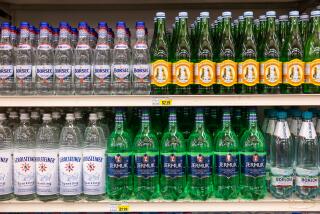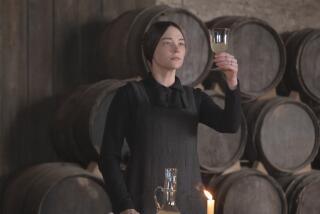Tasted 30 years later: They’re alive!
Napa — ON a spring afternoon in 1976, Stephen Spurrier, the English owner of a Parisian wine shop, and his partner, wine educator Patricia Gallagher (now known as Gastaud-Gallagher), staged an informal wine tasting in Paris for French wine experts in which upstart California wineries were pitted against the great domaines and chateaux of France. In a stunning turn of events, the California wines fetched the highest scores, besting their famous French counterparts. The tasting became known as the Judgment of Paris, and sent shock waves throughout the wine world.
Last week, to commemorate the event, wine critics from England, the U.S. and France gathered in panels chaired by Spurrier at the headquarters of London wine merchant Berry Bros. & Rudd, and by Gastaud-Gallagher at Copia (the American Center for Food, Wine and the Arts) in Napa to taste those same red wines from the early ‘70s and find out which, if any, held up.
Neither Spurrier nor Gastaud-Gallagher expected the attention -- or in the case of France, the derision -- that the original event generated. And when it came to the reenactment, Gastaud-Gallagher wasn’t certain that the wines, some now 37 years old, would show well. “I was thinking, ‘Will this be a celebration or a bitter moment?’ ” she said. “But when we pulled the corks, we found the wines to be very much alive, and thought, ‘Yes, this will be interesting, there may be surprises.’ ”
And for the second time, California wines recorded a stunning upset: Ridge Vineyards’ Monte Bello 1971 Cabernet took top honors in both cities, and the top red wine from the 1976 tasting, Stag’s Leap Wine Cellars 1973 Cabernet Sauvignon, took second place overall.
In fact, the judges’ top five wines were from California, prevailing over some of Bordeaux’s most famous, and famously long-lived wines, including Chateau Latour, Chateau Haut-Brion, Chateau Montrose, and Chateau Mouton-Rothschild.
In doing so, California proved that not only did its wines deserve the place they secured on the world stage in 1976; they had the longevity to stay there.
“It’s absolutely wonderful that California wines have shown that they can age as well as Bordeaux wines,” said Spurrier by speakerphone to the crowd in Napa. He may have been as surprised as anyone.
Though the reenactment was meant to commemorate a watershed moment in U.S. wine history, to many in the wine world the results last week seemed almost as shocking as those in 1976.
Count me among the surprised. As a nonvoting critic I was invited to blind-taste the 10 original red wines, from vintages as “young” as 1973 and as old as 1969. Like most, I was expecting the Bordeaux wines to prevail. The California wines were supposed to fade.
At last week’s tasting, each panel consisted of nine judges and represented some of the world’s most respected critics, sommeliers and wine professionals, including Stephen Brook, Andrea Immer-Robinson, M.S., Paul Roberts, M.S., Christian Vanneque and Jean-Michel Valette, M.W., in Napa; and Jancis Robinson, M.W., Jasper Morris, M.W., Hugh Johnson, and Michael Broadbent, M.W., in London.
It’s somewhat remarkable that the date is commemorated at all, as the original tasting wasn’t meant to be much more than a little fun. In 1976, to celebrate the American bicentennial, Spurrier and Gallagher decided to throw a blind tasting of French and American wines. They invited nine esteemed French wine experts, and Time magazine reporter George Taber was there. Taber was allowed to wander among the tables, where the judges were informally chatting with each other; at one point, Taber began to notice that they were mistaking the California wines for French -- and he realized there might be a story.
Millions read about California’s triumph in Taber’s article in Time two weeks later, and it is hard to overstate its impact. Until that day in 1976, French wines were considered the greatest in the world, and no one thought to question that hegemony. But nothing would be the same after the Judgment of Paris.
“The day after the Paris tasting,” says Warren Winiarski of Stag’s Leap Wine Cellars, whose 1973 Cabernet took top honors that year, “all that changed. We saw that great wine could be made in many countries.”
It wasn’t supposed to go this way. “What I was expecting was the downfall of California,” said Vanneque, the only judge in Napa who had been present at the original event. “We told ourselves [in 1976] that yes, the California wines won because they were more mature, they were too open, and they couldn’t last. Today’s tasting showed that that was not true; the California wines aged gracefully. They won also the test of time.”
California grapes, after all, were grown in warmer climates on young vines and made into wine by then-young, relatively inexperienced winemakers. The wines were generally showier, fruitier, more expressive than French wines in their youth. But they weren’t built like Bordeaux; they weren’t supposed to have the longevity of wines grown in a cooler region, crafted by the great chateaux.
Tasting 10 of the wines that figured in the Judgment of Paris, it was impossible not to think of their role in history; some, however, had clearly expired long before this day. My notes indicate that about half the wines were past their prime: “Pinched,” I wrote of one; “thin as a broth,” I wrote of another; “This one’s toast” of a third. “Rancid catsup spice and little to offer but astringency” were my rather unkind notes about two other wines that had obviously met their demise.
The good ones, though, were profound:
“Gorgeous aromas,” I wrote of one. “Sassafras, pine fronds, and cedar.”
“Vivid garnet,” I wrote of another. “Flavors of mint, black pepper, and earth.”
And this, from notes on my top-ranked wine: “The richest, most succulent of all -- incredibly seductive.”
Halfway through the tasting I realized that, just like the French critics in 1976, I didn’t have the slightest idea which wine came from which country (I knew better than to open my mouth, of course). It wasn’t until I’d heard the results that it dawned on me that history had repeated itself, not only in two cities, but on my tally sheet as well. My top five wines, in fact, were Californian: Mayacamas, Ridge, Heitz Martha’s Vineyard, Stag’s Leap, and Clos du Val.
And the wines that had fallen apart? All but one, I learned later, were from Bordeaux.
It’s not likely that Judgment of Paris II will have the same impact as the original, but it should provide some closure on any doubts that California wines can age exceedingly well. Then again it’s critical to remember that all of these were made in an era when wines -- even those from California -- were less ripe, less alcoholic, and generally much more restrained than they are now.
As if to prove the point, Copia’s Wine Director Peter Marks put a modern stamp on the proceedings by curating four additional flights, composed of wines from this decade, drawn from some of the same houses in Burgundy, Bordeaux and California used in the original tasting, as well as a few newcomers.
But unlike in the reenactment flight, these younger French and California wines did not compete against one another. Some protested the separation of France and California in the latter flights, but even if they had been tasted together, the young French and the California wines were so profoundly different from one another that there would have been little doubt which was which.
“That’s an apple, that’s an orange,” said Paul Roberts, who directs the wine programs at the French Laundry and Per Se. “What’s the point of judging one against the other?”
And once again, Ridge Monte Bello, from the 2000 vintage, took top honors among California Cabernet-based wines, and Stag’s Leap Wine Cellars’ 2001 Cask 23 Cabernet bottling took second place.
Within categories too the judges seemed to favor balance and elegance over big, high alcohol content wines: The choice of Paul Draper’s 2000 Ridge Monte Bello, an elegant wine grown in the much cooler, mountain/maritime climate of the Santa Cruz mountains, seems to back this up. “Monte Bello is as cool as Bordeaux,” he pointed out, “and it can be more like a Bordeaux wine.”
That is certainly the sense Draper had when he tasted his first wines from the vineyard from early ‘60s vintages, which persuaded him to come on as winemaker in 1969. While his Monte Bellos have crept up in alcohol, they usually come in several points lower than his colleagues’ efforts in the north.
“Personally, I’d love to see the Napa Valley back away from high alcohol wines,” he says, “and give Cabernet a chance to show its complexity, rather than just an over-ripened quality.”
Stag’s Leap’s Winiarski, who with Draper was one of many elder statesmen present at Copia, was quick to agree. “It’s happening on both sides of the Atlantic,” he told me the next day. “Raisins from Greece taste the same as raisins from California. If you lose that element of restraint, the distinctiveness of the place where the grapes are grown is lost.”
Aside from ripeness levels, there were other differences between last week’s tasting and the one 30 years ago. Vanneque, looking out on three rows of reporters and photographers, noted, “The last time we did this there was no press, except George.” Taber himself seemed astonished by the solemnity. “They’re all so deadly serious,” he remarked, referring to the judges. “In 1976 it was just a fun afternoon; you’d think this was a Council of War or something.”
In fact, in Napa, once the work was out of the way, the mood was fairly celebratory, well before anyone knew the results.
“Thirty years ago no one knew we would be celebrating this event,” said Winiarski, “and every year its impact seemed to get bigger and bigger.”
What conclusion are we to draw from all this?
“There is great doubt in my own mind,” wrote wine critic and author Nathan Chroman in The Times 30 years ago about the original Judgment of Paris, “as to whether these types of odious comparisons really prove anything more than that people who should know better like to indulge in them.” But he goes on to say that it used to mean something to compliment a California bottling by mistaking it for French.
“Those days are gone forever,” he writes, “as California wines can stand alone nicely, thank you.”
Apparently those words age nicely too.
*
(BEGIN TEXT OF INFOBOX)
Judgment in Paris 30 years later
These are the results of the anniversary Judgment of Paris tasting of red wines from France and California held May 24, simultaneously in London, at Berry Bros. & Rudd, and in Napa, at Copia. The listing represents the combined scores of nine judges in London and nine in Napa. The second number, in parentheses, represents the rank of the wine in 1976.
For a complete list of results, including the rankings of younger vintage wines from California, Bordeaux and Burgundy from four subsequent flights and this one, visit www.copia.org.1. 1971 Ridge Vineyards Monte Bello, Santa Cruz Mountains (5)
2. 1973 Stag’s Leap Wine Cellars Cabernet Sauvignon, Napa Valley (1)
3. (TIE) 1970 Heitz Martha’s Vineyard Cabernet Sauvignon, Napa Valley (9) and
3. (TIE) 1971 Mayacamas Cabernet Sauvignon, Napa Valley (7)
5. 1972 Clos du Val Cabernet Sauvignon, Napa Valley (8)
6. 1970 Chateau Mouton-Rothschild, Paulliac (2)
7. 1970 Chateau Montrose, Saint Estephe (4)
8. 1970 Chateau Haut-Brion, Graves(3)
9. 1971 Chateau Leoville-Las-Cases, Saint-Julien (6)
10. 1969 Freemark Abbey Cabernet Sauvignon, Napa Valley (10)
-- Patrick Comiskey
More to Read
Eat your way across L.A.
Get our weekly Tasting Notes newsletter for reviews, news and more.
You may occasionally receive promotional content from the Los Angeles Times.










